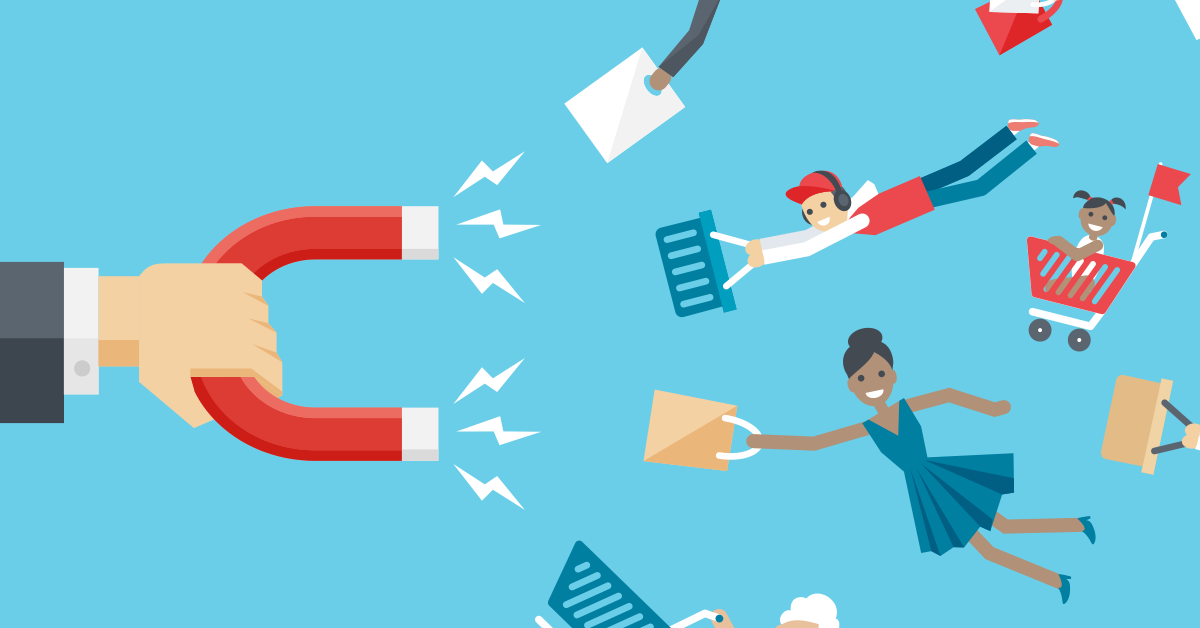
One of the smartest things you can do in business is to identify marketing channels that can generate leads that (preferably) meet these 3 criteria:
- Sales qualified: Email is affordable and scalable but generates leads that are far from making a buying decision and often need to be nurtured.
- Easily scalable: Cold calling is effective for creating qualified leads but is tough to scale and expensive.
- Affordable: Content is good for creating qualified leads but is tough to scale, and when you look at the time it takes to create great content, it’s easily one of the most expensive activities in marketing.
While many marketing channels can hit one or two of these requirements, few can meet all three.
SMS marketing is one of those rare few channels that can deliver highly qualified leads at scale and is affordable at only a few cents per send.
Here is what Smart Insights had to say about the power of SMS:
- Over 97% of text messages are read within the first four minutes.
- 19% of people will click a link in an SMS campaign rather than just 4.2% for emails.
- SMS campaigns receive average response rates of 30%, compared to 4% for emails.
It’s tough to find anything else that can consistently hit numbers that even the best marketers dream of.
In this short guide, you’ll learn the 4 key phases to building an SMS list of hungry buyers from scratch that will help you drive more leads, bookings and appointments into your business regardless of the industry to generate sales on demand.
The Secret To A Successful Bulk SMS Marketing Campaign
David Deutsch, one of the world’s most sought-after direct response copywriters, said that the best marketers obsess about their customers.
Turns out that the best marketers eat, sleep and breathe everything about the person they are trying to influence.
Makes sense.
The late Jim Camp, known as the most feared negotiator on the planet who routinely negotiated deals worth half a billion dollars, had this interesting insight:
“You’re always safe as long as you’re in the other person’s world.”
As long as you’re talking about what the other person wants and the problems they are experiencing, you can guide them towards your solution.
Once you understand your customer’s world (fears, frustration, wants, and aspirations), it becomes easier to guide them toward your product or service.
How do we get inside the world of our customer?
We do this by creating a Buyer Persona.
What Is A Buyer Persona?
A buyer persona is a fictional character representing a real customer segment.
For example, a personal trainer may help:
- The skinny guy who wants to put on muscle.
- The 40+ male who wants to get abs.
- The woman is 10 kilos overweight and wants to look like she did back in university.
- The person who has suffered an injury must rehabilitate and strengthen that area.
- The person secretly fears being dropped from their team and wants to become a high-performer in their sport.
It’s impossible to effectively appeal to every one of these people in one advertisement.
Each of these people has a unique problem and desires a unique outcome.
How can you speak to the 40+ male who wants to get abs while also talking to the skinny who wants to build muscle? They may seem similar – they are not.
You can’t.
Yet, a lot of businesses try.
The result is poor marketing performance.
By developing a buyer persona for each person, you will be able to use the right words, angles, hot buttons, and offers that will be incredibly hard for them to ignore.

PHASE 1: Developing Your Buyer Persona
Below I’ve put together a list of questions to ask yourself about each customer group you serve.
You don’t need to have an answer for every single question you may be able to get away with basic demographics and what that person wants and still generate leads with SMS, but I’ve included some other questions to get you thinking from different angles.
There are 3 basic areas to look at:
- Demographics
- Motivators
- Habits and beliefs
DEMOGRAPHICS
This helps you to understand their personal situation to give you an idea of potential solutions or bundles would be more appealing and also how you write to them, so here are some questions…
- Are they male or female?
- Do they own a business?
- Are they employed? What position?
- How much do they earn per year?
- Are they married with kids? Married with no kids? Single with kids? Single professional? De-facto?
MOTIVATORS
This helps you understand their internal motivators.
By knowing what motivates your buyer persona, you can connect these to your solutions and build awareness around other solutions they may not have considered.
- What goals does your buyer persona want to accomplish? (as it relates to your product or service)
- What do they think is preventing them from achieving those goals? (personal life, education/experience, finances, emotions)
- How does not solving that problem affect them? (personal life, education/experience, finances, emotions)
- What undesirable symptoms are they experiencing as a result of those problems?
- Is there a root problem your persona is unaware of that is feeding those undesirable symptoms?
- What have they tried in the past to solve their problem?
- What wants and desires does your buyer persona have?
- Who do they need to rationalise their buying decision to? (Boss? Significant other etc.)
- What do they ultimately want to achieve by using your solution? (Promotion, admiration, better relationships etc.)
HABITS & BELIEFS
- Where do they spend their time online? (ex. Which blogs do they read? Facebook groups etc.)
- When they want to search for a solution like yours, what keywords do they type into Google or Bing?
- What do they believe about the current problem they have? (What are the correct assumptions, and what are the incorrect assumptions?)
- What do they believe about the solution they think they need? (Are there any incorrect assumptions?)
Here are 3 examples of buyer personas:
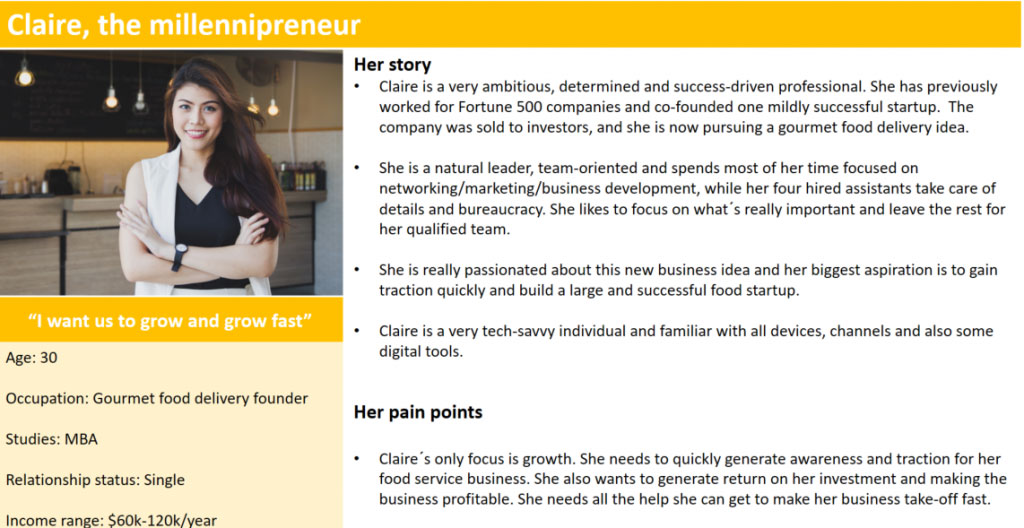
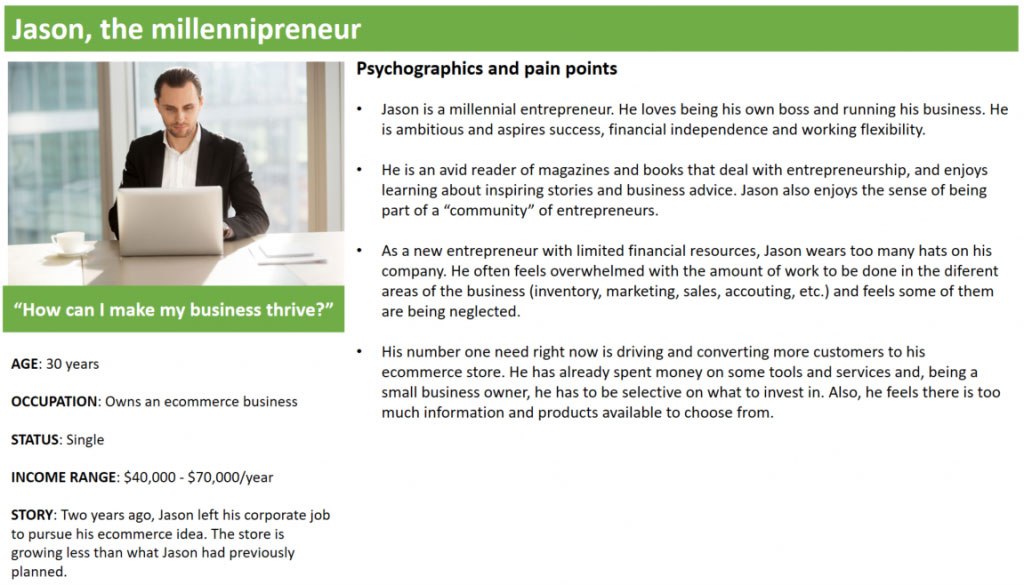
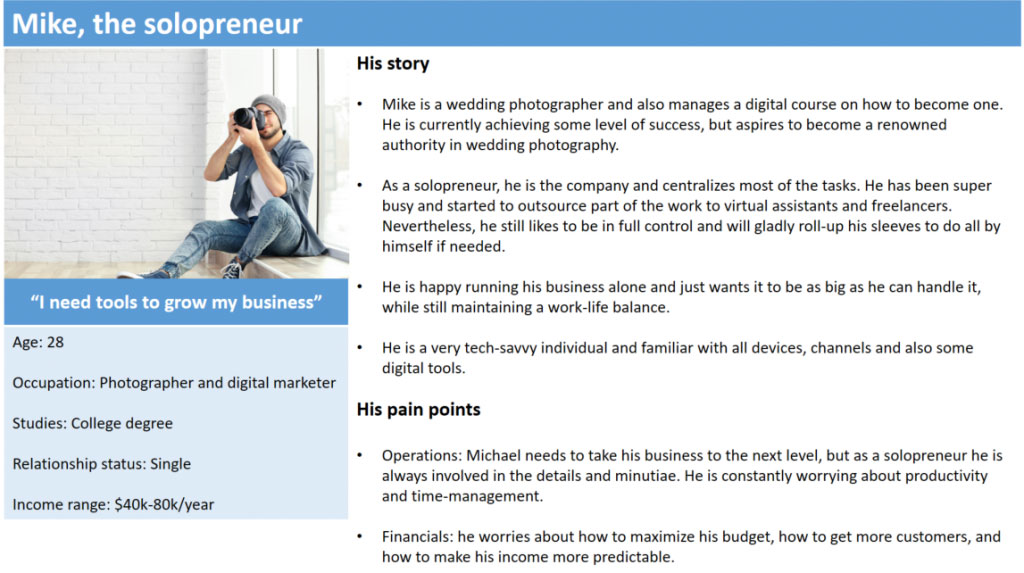
START COLLECTING CUSTOMER INFORMATION
- Talk to your frontline team (sales reps, customer service, account managers etc.) to learn about each buyer persona’s specific wants, needs, pains, and desires.
- Put all this information into a document, digital is ok, but paper is better.
- Go to Google images and find a photo of a person that would represent your buyer persona.
- Give your persona a name.

OFFERS 101
What would your buyer persona find irresistible?
Without a finely tuned offer, you’re not going to generate leads, period.
This is why building your persona is important: it lets you know what offer is likely to appeal to that specific person.
First, what is an offer?
You’re offering something that is of value to another person.
“You want a bottle of milk to make coffee? I have a bottle of milk, would you like it?”
That’s an offer.
Here’s a quick example:
If you’re a real estate agent and want to generate a list of people currently thinking about putting their home on the market, you can offer them an informational guide outlining how many properties are selling in their location.
Informational offers are great because they can be used in virtually any industry, especially if you’re selling products or services requiring a customer to research before buying.
FRONTEND VS BACKEND OFFERS
The front-end offer is the offer that gets people onto your list = lead/customer acquisition
The back-end offer is what keeps people on your list = repeat sales generation
Before you craft your first offer, you should consider what types of backend offer you will promote to new subscribers once they get on your list.
For example: will your front-end offer be a trial, and your backend offers the full solution at a reduced price?
Or will your front-end offer be your full solution and your back-end offer complimentary to that solution?
It’s best to create a plan before you develop your first offer.
12 BASIC OFFER TYPES
Below I’ve listed 11 different offer types popular with SMS – you can see these in more detail in our blog post “20 Promotional Offers To Generate More Customer Leads.”
- Buy One, Get One Free
- Free Delivery
- Gift Vouchers
- Standard Discounts (10% off etc.)
- Free Workshops
- Demographic-Based Discounts (student, elderly etc.)
- Free ‘X’ If You Buy Before ‘Y’
- Free Trials/Try Before You Buy
- Free ‘X’ When You Buy ‘Y’
- Package Deals
- Better Payment Terms
- Free reports and guides

PHASE 2: CRAFTING AN IRRESISTIBLE SMS OFFER
Remember the story of Hansel & Gretal?
The witch who built that house made of candy understood her target market.
As a child, there would be nothing more magnificent than stumbling upon an entire house made of candy, right?
With that in mind, it’s time to craft an offer that would be very difficult for your buyer persona to ignore.
The key to crafting an irresistible offer is understanding the specific pain point the prospective buyer is grappling with and the desired result they ultimately want.
The offer must bridge the gap between those two worlds (your solution) or help a person take the first step toward their desired goal (trial or part of the solution).
Full solution example: If you’re a personal trainer and your buyer persona (typically) wants to lose 10 kilos in less than 90 days, that needs to be the offer (assuming you can fulfil that promise).
Trial or part of solution example: Free 30-day weight loss meal plan. This doesn’t completely solve the problem but is enough to get them to see a small result bringing them closer to your solution.
What offers is your buyer persona currently being exposed to?
The more a person sees an offer, the more de-sensitised they become to it.
The last thing you want to trigger is this response:
“Oh yeah, I’ve heard/seen/tried that before.”
This will deaden the impact of your offer.
Understanding what is currently being offered is critical to make a different offer.
The BEST strategy is to create a unique offer that your customer has never seen before.
Note down all of the existing offers on the market:
- Can you make your offer better or even totally unique?
- Can you make the payment plan more favourable?
- Can you deliver a result faster?
- Do you deliver the result in a new and interesting way?
- Do you specialise in solving specific problems inside niches?
Once you have a rough idea of your offer, it’s time to polish it up and run it through the 4U’s…
THE 4U’s
The 4U’s is a popular marketing framework that many copywriters use to take an ordinary offer and make it extraordinary.
The 4U’s stand for:
- Useful
- Urgency
- Unique
- Ultra-specific
For example:
Lose weight before summer hits with our Pre-Summer Fit Bootcamp. Text “SFIT” to XXXXXXXX, and we’ll text you the details.
Let’s run this through the 4U framework:
New Mums! Lose 12 kilos in 2 months with our ‘New Mums Pre-Summer Fit Bootcamp’. Text “SFIT” to XXXXXXXX, and we’ll text you the details. Only 40 spots are available. The offer ends on 30-09-2018.
- Is it useful?
We’re targeting new mums who have trouble losing baby weight and are keen to lose it before summer.
- Is there urgency?
40 spots only + offer ending 30-09-2018.
- Is it Unique?
The boot camp is targeted at new mums carrying baby weight, so the workouts will be more specific so to solve that problem, you could argue that it is unique.
- Is it ultra-specific?
12 kilos in 2 months tells the reader what result they can expect to achieve and in what timeframe.
Do you need to use all 4U’s?
No, at the very least, you want 2 but preferably 3.
Now that you have your target customer in mind and the irresistible offer, it’s time to build the lead capture system.

PHASE 3: SETTING UP YOUR LEAD CAPTURE SYSTEM WITH 160.COM.AU
Let me walk you through the mechanics of SMS lead capture.
The worst thing you can do in SMS marketing is to pile everyone into the same contact group.
You know which buyer personas you want to target, and now it’s time to set up different group segments, so we keep each group separated.
USE SEGMENTATION TO IMPROVE CONVERSION RATES
In SMS, we segment each persona by using what I call ‘Group Buckets’.
Group buckets are contact groups that pull in new subscribers based on the keyword a potential customer has texted to you.
For example:
Let’s say I am targeting personal trainers to help them grow their PT business, and I create a ‘group bucket’ named “Personal Trainer Pete” (based on my buyer persona), and I link that contact group to the keyword ‘KB50’ – the offer may look like the following:
Text ‘KB50’ to XXXXXXXX and get 50% off my ‘2x Kettlebell Master Training Method’ that my students have used to double their personal training business in as little as 60 days.
When anyone texts the keyword ‘KB50’, they will be automatically added to the ‘Personal Trainer Pete’ contact group for me to follow up with at leisure.
Let’s create our first Group Bucket:
STEP 1: once you’ve logged into your online SMS account, you’ll see this screen:
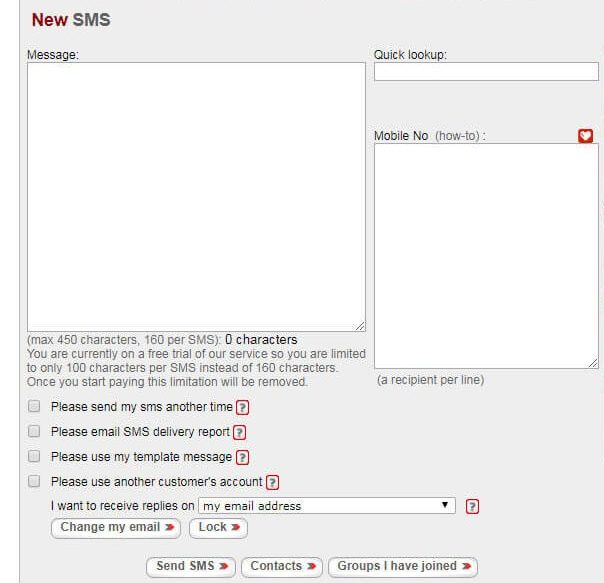
STEP 2: Select I want to receive replies on “mobile number for communication groups” and click on the “contacts” button underneath.
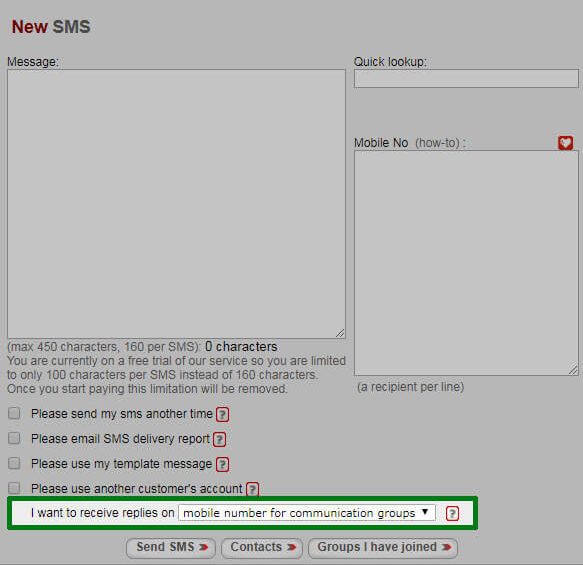
STEP 3: In the “group name field” I’ll add in my buyer persona name, click the drop-down box and make sure “messaging group” is selected and click on the “apply changes” button.

STEP 4: Now that your new contact group bucket has been created we need to link a special keyword to that group. Click on the “0 records” link on the far right.

STEP 5: Enter in the special keyword you want to be associated with this account. Add your keyword into the “Keyword” field and then click the “update changes” button on the right.

STEP 6: I’ve entered the keyword: “KB50” (screenshot below), which I’ll use to give away Kettlebell Classes for 50% off, for example.
Notice that there are instructions at the top that tell you how to use the keyword to get people to join your SMS list (see below).
In this example, when someone texts KB50 to 61401463595, they are automatically added to the KB50 group bucket.
There are also instructions on how people can unsubscribe from your list also.
This will be different for every new group you create.
That’s it!
You have now created an SMS group so that whenever anyone texts your special keyword to the virtual mobile number provided, they will be automatically added to this group.


PHASE 4: PROMOTION
All of the groundwork has been completed you now have:
- A good idea of your buyer persona
- What specific offer would they find irresistible
- Set up your lead capture machine
All you need to do now is fill it up with customer leads, and we do this by promoting your offer.
The best place to start your promotional campaign is to leverage your existing marketing channels. Once you know you have a proven winner (an offer that generates a good number of leads predictably, you would look to move into other channels.)
Assess your existing marketing channels:
- Website: This new promotion should be used in high-traffic areas (i.e. your website homepage) and areas that are relevant to that promotion. For example, a general health website would likely cover different areas like yoga, gut health, nutrition, diets etc., so they would have different promotions running to capture these audiences, so it would make sense to run a yoga promotion on any page or article that talks about that topic.
- Blog content: Placing a promotion on your blog articles is a fantastic way to move the relationship ahead and gain a commitment.
- Paid Ads: If you’re running paid ads, then promoting your offer on this channel helps you reach people who haven’t yet made it to your site and are more highly committed to a solution like yours.
- Email/Newsletter: Since people are already happy to hear from you by subscribing to your list, there will be a good number who would also be open to the idea of receiving SMS messages from you. Just be sure that you create a special aura around becoming an SMS subscriber Moving people from one channel to another is a good way to extend your reach. Creating a special SMS group will likely improve your sales numbers due to the incredibly high open and response rates. Email and SMS marketing makes a fantastic one-two punch so put them to work together.
- Social Media: Your promotion should walk alongside your social media marketing campaigns.
- Influencers: Influencers can give your promotion legs, so it may be worth testing. Influencers you do not have an existing relationship with will want to be compensated, so it’s best you have a proven offer that works predictably there is also an opportunity to trade goods for influencer promotion.
- Store POS: Point of sale is a good spot because you’re getting your promotion in front of proven buyers.
- Sandwich Board/Signage: You’ll want to be fairly active with your SMS promotion and get it onto as many of your marketing channels as possible.
Where Are We?
- Phase 1: Developed a basic buyer persona
- Phase 2: Created a frontend offer and have prepared your backend offers
- Phase 3: Built our SMS lead capture system
- Phase 4: Made a list of promotional channels to integrate our SMS offer into
That’s it.
Once you begin building up your list, you will now have a growing group of targeted leads that you can send out bulk SMS marketing campaigns to generate sales on demand!
Ready To Try SMS Marketing?
Start your free trial with us today and we’ll
add a few SMS credits so you can see how it all works.
Click Here To Get Started!
Related Articles:
- Are you making these 13 SMS marketing mistakes?
- Guide To SMS Marketing
- 16 Pro tips for SMS marketing
- 3 SMS marketing tricks that boost sales
